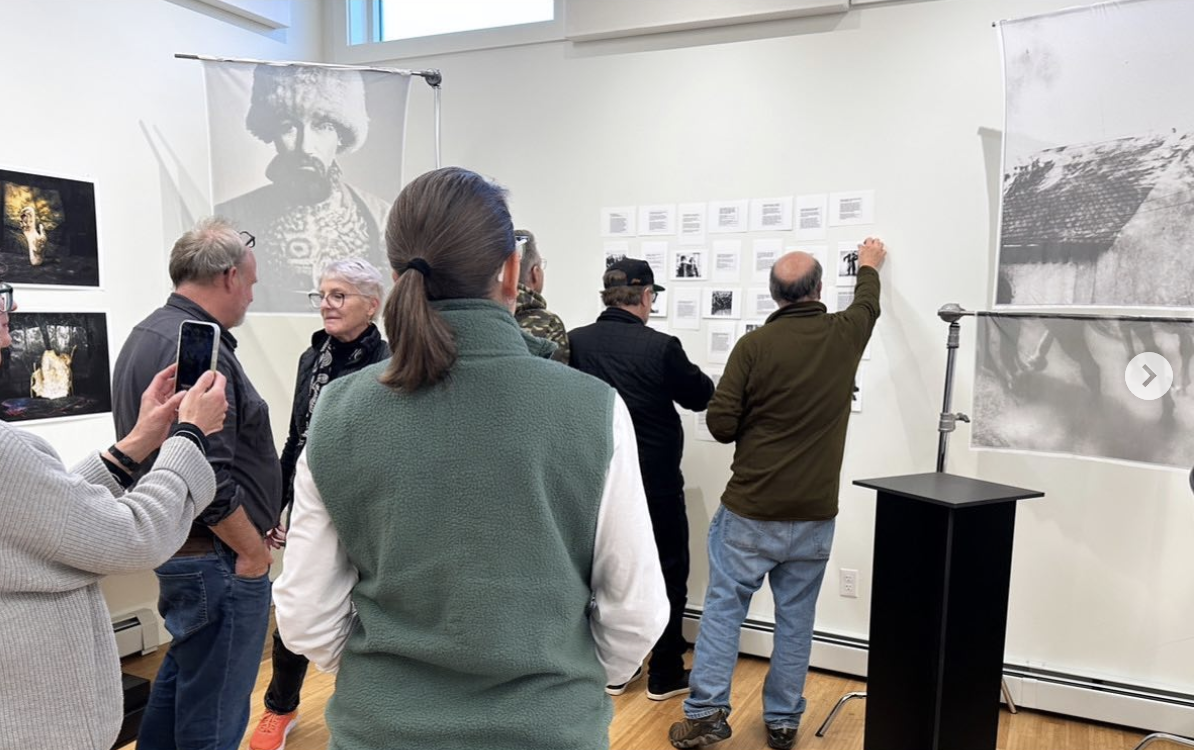 Classmates engaging with the work.
Classmates engaging with the work. The following is an excerpt from a recent interview about my work, “The Last Jews of Liuh,” a collaboration between my imagination and DALL-E 2 (AI).
1. What was your intention with the work? And to what extent was this driven by curiosity about the technology itself (DALL-E 2)?
I saw an exhibition of DALL-E images created by film director Bennett Miller back in July 2022. They were installed at the Gagosian Gallery, so a genuinely “major” (as in legitimate) gallery space. I walked in and my jaw dropped. The exhibition, “A Wild Wild Wind,” addressed the question of the future fast approaching, put through the lens of a past that has now disappeared. In other words, how do we summon ghosts? How do we truly remember the past and therefore teach ourselves to be present to the present? It was extraordinary and I was thoroughly blown away.
I kept thinking about the idea of using AI for portraits that not only reflected the present (that’s the easy part, especially for the selfie-generation) but could summon the past. Summon memory. And it struck me that I could take my own family story and use it to create a “proxy” for what life might have been like. We had no photographs. Liuh no longer exists. There is no way to visually access a sense of Liuh unless you dive into memory.
2. Do you consider AI a tool? Has your opinion of this changed since you’ve become more adept with the technology?
I began by seeing DALL-E 2 as a tool. I would say to people, “It’s like Photoshop. It lets you tweak and edit.” But I no longer say that. AI is more than a tool. AI is a mindset. It is a way of thinking and of conceptualizing the work that places language (e.g., the caption) as the point of departure, and the image that results as the object. It is driven as much by poetry and metaphor as it is by descriptors.
3. Are the prompts more factual or more poetic in nature?
They are a combination. And, as a writer, they function in very much the same way as rough drafts. I typically do 30-35 versions of a single image. The first five or so (this is not scientific) are factual — “give me a young Eastern European Jewish woman, dark hair, fair skin, flat ears, slight smile, stirring a pot on a stove with a big wooden spoon. It is 1911 and it is summer. Make it authentic and photographic.” That’s about all I say. The algorithm comes back with mostly awful images. The hands are monstrous and the faces often look like ghouls. But at some point I will get one that I feel is close to my concept. Then, in tiny increments (one hand, one eye, one eyebrow, the part in the hair, etc.), and one by one, I begin to feed more nuanced information and descriptions into the algorithm. I might say, “Shoulder length hair, creamy peach skin, a slight blush on the round cheeks,” etcl). Then, in the last five or so, I will apply much more conceptual prompts, like “Tchaikovsky romantic Russian music, sense of pathos, deep love of poetry. Those are the most interesting changes. The person comes alive.
4. Do you feel your work is “ethical?”
Well, this is the million dollar question. I would not ever try to pass off the images as photographs. There is no camera involved. So, no lying, that’s the first thing to know. I believe that the work I’ve done is ethical, yes. I am respectful, I am deeply aware of the potential for stereotypes (a huge nose, frizzy hair, etc.) and I actively work against such representation. I am not lobbying to have this work included in history books or documentary projects. I am straightforward about the collaboration with DALL-E 2. What feels deeply unethical to me is the perpetuation of stereotypes and the propagation of unflattering and sensitive issues; e.g., very large lips for Black people, etc.
Key point: AI itself is neither ethical nor unethical. The artist is responsible for using the technology with sensitivity and awareness.
5. How do you start with a new series in AI?
Some say it starts with the Word. But, again, in my mind this is a bit reductive. I believe it’s more a seed of an idea. You plant that seed into the AI and it comes back with options (variations). The artist coaxes the AI into “hallucinating” in your intended direction.